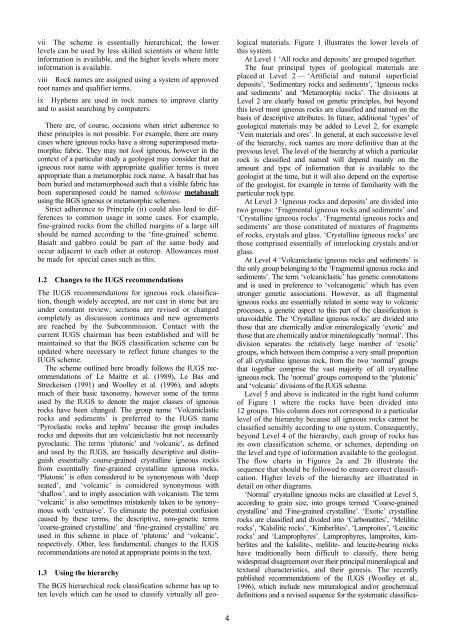Rock Classification Scheme (BGS).pdf - The Water, Sanitation and ...
Rock Classification Scheme (BGS).pdf - The Water, Sanitation and ...
Rock Classification Scheme (BGS).pdf - The Water, Sanitation and ...
You also want an ePaper? Increase the reach of your titles
YUMPU automatically turns print PDFs into web optimized ePapers that Google loves.
vii <strong>The</strong> scheme is essentially hierarchical; the lowerlevels can be used by less skilled scientists or where littleinformation is available, <strong>and</strong> the higher levels where moreinformation is available.viii <strong>Rock</strong> names are assigned using a system of approvedroot names <strong>and</strong> qualifier terms.ix Hyphens are used in rock names to improve clarity<strong>and</strong> to assist searching by computers.<strong>The</strong>re are, of course, occasions when strict adherence tothese principles is not possible. For example, there are manycases where igneous rocks have a strong superimposed metamorphicfabric. <strong>The</strong>y may not look igneous, however in thecontext of a particular study a geologist may consider that anigneous root name with appropriate qualifier terms is moreappropriate than a metamorphic rock name. A basalt that hasbeen buried <strong>and</strong> metamorphosed such that a visible fabric hasbeen superimposed could be named schistose metabasaltusing the <strong>BGS</strong> igneous or metamorphic schemes.Strict adherence to Principle (ii) could also lead to differencesto common usage in some cases. For example,fine-grained rocks from the chilled margins of a large sillshould be named according to the ‘fine-grained’ scheme.Basalt <strong>and</strong> gabbro could be part of the same body <strong>and</strong>occur adjacent to each other at outcrop. Allowances mustbe made for special cases such as this.1.2 Changes to the IUGS recommendations<strong>The</strong> IUGS recommendations for igneous rock classification,though widely accepted, are not cast in stone but areunder constant review; sections are revised or changedcompletely as discussion continues <strong>and</strong> new agreementsare reached by the Subcommission. Contact with thecurrent IUGS chairman has been established <strong>and</strong> will bemaintained so that the <strong>BGS</strong> classification scheme can beupdated where necessary to reflect future changes to theIUGS scheme.<strong>The</strong> scheme outlined here broadly follows the IUGS recommendationsof Le Maitre et al. (1989), Le Bas <strong>and</strong>Streckeisen (1991) <strong>and</strong> Woolley et al. (1996), <strong>and</strong> adoptsmuch of their basic taxonomy, however some of the termsused by the IUGS to denote the major classes of igneousrocks have been changed. <strong>The</strong> group name ‘Volcaniclasticrocks <strong>and</strong> sediments’ is preferred to the IUGS name‘Pyroclastic rocks <strong>and</strong> tephra’ because the group includesrocks <strong>and</strong> deposits that are volcaniclastic but not necessarilypyroclastic. <strong>The</strong> terms ‘plutonic’ <strong>and</strong> ‘volcanic’, as defined<strong>and</strong> used by the IUGS, are basically descriptive <strong>and</strong> distinguishessentially coarse-grained crystalline igneous rocksfrom essentially fine-grained crystalline igneous rocks.‘Plutonic’ is often considered to be synonymous with ‘deepseated’, <strong>and</strong> ‘volcanic’ is considered synonymous with‘shallow’, <strong>and</strong> to imply association with volcanism. <strong>The</strong> term‘volcanic’ is also sometimes mistakenly taken to be synonymouswith ‘extrusive’. To eliminate the potential confusioncaused by these terms, the descriptive, non-genetic terms‘coarse-grained crystalline’ <strong>and</strong> ‘fine-grained crystalline’ areused in this scheme in place of ‘plutonic’ <strong>and</strong> ‘volcanic’,respectively. Other, less fundamental, changes to the IUGSrecommendations are noted at appropriate points in the text.1.3 Using the hierarchy<strong>The</strong> <strong>BGS</strong> hierarchical rock classification scheme has up toten levels which can be used to classify virtually all geologicalmaterials. Figure 1 illustrates the lower levels ofthis system.At Level 1 ‘All rocks <strong>and</strong> deposits’ are grouped together.<strong>The</strong> four principal types of geological materials areplaced at Level 2 — ‘Artificial <strong>and</strong> natural superficialdeposits’, ‘Sedimentary rocks <strong>and</strong> sediments’, ‘Igneous rocks<strong>and</strong> sediments’ <strong>and</strong> ‘Metamorphic rocks’. <strong>The</strong> divisions atLevel 2 are clearly based on genetic principles, but beyondthis level most igneous rocks are classified <strong>and</strong> named on thebasis of descriptive attributes. In future, additional ‘types’ ofgeological materials may be added to Level 2, for example‘Vein materials <strong>and</strong> ores’. In general, at each successive levelof the hierarchy, rock names are more definitive than at theprevious level. <strong>The</strong> level of the hierarchy at which a particularrock is classified <strong>and</strong> named will depend mainly on theamount <strong>and</strong> type of information that is available to thegeologist at the time, but it will also depend on the expertiseof the geologist, for example in terms of familiarity with theparticular rock type.At Level 3 ‘Igneous rocks <strong>and</strong> deposits’ are divided intotwo groups: ‘Fragmental igneous rocks <strong>and</strong> sediments’ <strong>and</strong>‘Crystalline igneous rocks’. ‘Fragmental igneous rocks <strong>and</strong>sediments’ are those constituted of mixtures of fragmentsof rocks, crystals <strong>and</strong> glass. ‘Crystalline igneous rocks’ arethose comprised essentially of interlocking crystals <strong>and</strong>/orglass.At Level 4 ‘Volcaniclastic igneous rocks <strong>and</strong> sediments’ isthe only group belonging to the ‘Fragmental igneous rocks <strong>and</strong>sediments’. <strong>The</strong> term ‘volcaniclastic’ has genetic connotations<strong>and</strong> is used in preference to ‘volcanogenic’ which has evenstronger genetic associations. However, as all fragmentaligneous rocks are essentially related in some way to volcanicprocesses, a genetic aspect to this part of the classification isunavoidable. <strong>The</strong> ‘Crystalline igneous rocks’ are divided intothose that are chemically <strong>and</strong>/or mineralogically ‘exotic’ <strong>and</strong>those that are chemically <strong>and</strong>/or mineralogically ‘normal’. Thisdivision separates the relatively large number of ‘exotic’groups, which between them comprise a very small proportionof all crystalline igneous rock, from the two ‘normal’ groupsthat together comprise the vast majority of all crystallineigneous rock. <strong>The</strong> ‘normal’ groups correspond to the ‘plutonic’<strong>and</strong> ‘volcanic’ divisions of the IUGS scheme.Level 5 <strong>and</strong> above is indicated in the right h<strong>and</strong> columnof Figure 1 where the rocks have been divided into12 groups. This column does not correspond to a particularlevel of the hierarchy because all igneous rocks cannot beclassified sensibly according to one system. Consequently,beyond Level 4 of the hierarchy, each group of rocks hasits own classification scheme, or schemes, depending onthe level <strong>and</strong> type of information available to the geologist.<strong>The</strong> flow charts in Figures 2a <strong>and</strong> 2b illustrate thesequence that should be followed to ensure correct classification.Higher levels of the hierarchy are illustrated indetail on other diagrams.‘Normal’ crystalline igneous rocks are classified at Level 5,according to grain size, into groups termed ‘Coarse-grainedcrystalline’ <strong>and</strong> ‘Fine-grained crystalline’. ‘Exotic’ crystallinerocks are classified <strong>and</strong> divided into ‘Carbonatites’, ‘Meliliticrocks’, ‘Kalsilitic rocks’, ‘Kimberlites’, ‘Lamproites’, ‘Leuciticrocks’ <strong>and</strong> ‘Lamprophyres’. Lamprophyres, lamproites, kimberlites<strong>and</strong> the kalsilite-, melilite- <strong>and</strong> leucite-bearing rockshave traditionally been difficult to classify, there beingwidespread disagreement over their principal mineralogical <strong>and</strong>textural characteristics, <strong>and</strong> their genesis. <strong>The</strong> recentlypublished recommendations of the IUGS (Woolley et al.,1996), which include new mineralogical <strong>and</strong>/or geochemicaldefinitions <strong>and</strong> a revised sequence for the systematic classifica-4
















